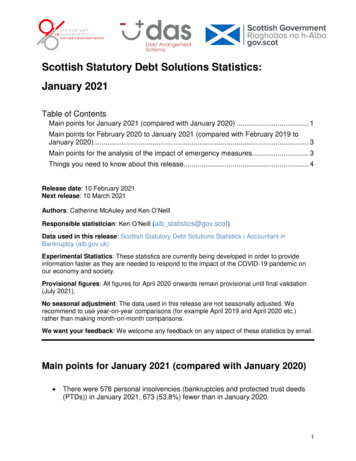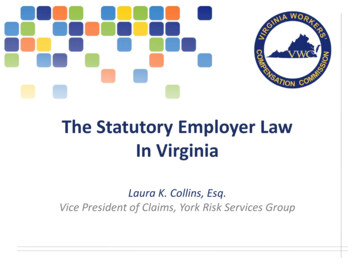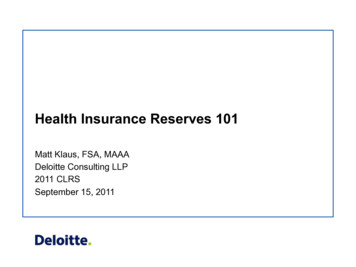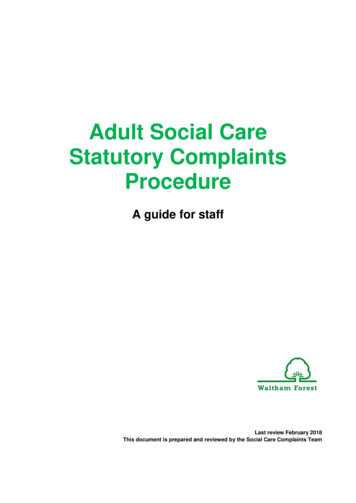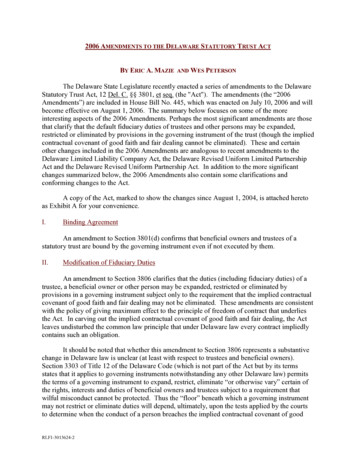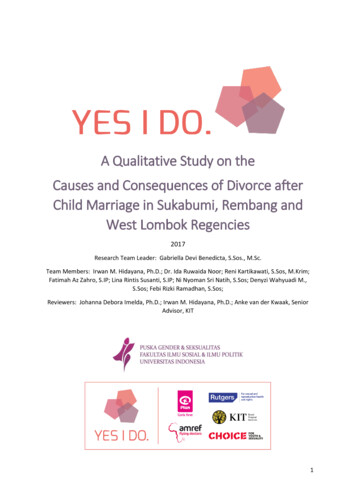
Transcription
The Consequences of the Statutory RegulationF OSMANPER / PELJ 2019 (22)of Customary Law: An Examination of theSouth African Customary Law of Succession and Marriage1F Osman*Online ISSN1727-3781AbstractPioneer in peer-reviewed,open access online law publicationsAuthorFatima OsmanAffiliationUniversity of Cape TownSouth AfricaEmail Fatima.Osman@uct.ac.zaDate Submission24 December 2018Date Revised2 July 2019Date Accepted20 September 2019Date publishedIn pluralistic legal systems, the regulation of non-state lawthrough statute carries the risks associated with codification;namely the ossification and distortion of law. This articleexamines the effects of statutory regulation on unwrittensystems of law in the South African legal context. It argues thatthe constitutional recognition of customary law in South Africahas forced the state to legislate in this arena, the most notableenactments being the Recognition of Customary Marriages Act120 of 1998 and the Reform of Customary Law of Successionand Regulation of Related Matters Act 11 of 2009. Theenactments' attempt to align customary law with constitutionalvalues have imported significant portions of the common law toregulate the customary law of marriage and succession. Thishas resulted in a distortion of customary law to reflect commonlaw values and rules. Furthermore, it is argued that significantlacunae in the enactments have necessitated litigation andresulted in the judiciary playing a significant role in shapingcustomary law. Finally, despite the incorporation of livingcustomary law into the enactments, the implementation thereofby courts and in practice has – and perhaps inevitably so –ossified and distorted portions of the law. Nonetheless, thearticle argues that legislation is critical to regulate customarylaw. It advocates that the shortcomings identified in the articleare addressed to ensure a more accurate portrayal ofcustomary law in legislation and the successful implementationthereof.11 December 2019Guest EditorsKeywordsMs F Osman and Prof C HimongaHow to cite this articleOsman F "The Consequences ofthe Statutory Regulation ofCustomary Law: An Examination ofthe South African Customary Lawof Succession and Marriage" PER /PELJ 2019(22) - 1/2019/v22i0a7592South Africa; distortion; customary law; marriage; succession;official customary law; living customary law .
F OSMANPER / PELJ 2019 (22)21 IntroductionIn pluralistic legal systems, states often seek to regulate unwritten systemsof non-state law, such as indigenous or customary law,1 to ensurecompliance with the overarching legal system. For example, duringapartheid, the South African state shamelessly used the BlackAdministration Act2 to implement the state agenda of segregation andcontrol of the indigenous population.3 The Act was crafted to solidify statecontrol rather than reflect actual customary law principles.Today, the South African state equally uses legislation to regulatecustomary law matters. While such legislation is not steeped in the raciststate agenda of the past, it is questionable whether the regulation amountsto a codification of customary law with an inevitable ossification anddistortion of the law. This article analyses the consequences of thestatutory regulation of customary law through an examination of two of themost prominent pieces of legislation dealing with customary law in SouthAfrica, namely the Recognition of Customary Marriages Act4 and theReform of Customary Law of Succession Act.5The article first explains the need for statutory regulation in light of SouthAfrica's constitutional recognition of customary law. It argues thatlegislation seeks to develop customary law to reflect constitutionalprinciples and norms though this may not materialise in practice.Legislative developments tend to distort customary law as common lawconcepts are imposed on customary law. Ultimately, South Africanlegislation has mixed consequences. Nuanced drafting has sought tocapture living customary law practices but on the other hand poor draftingand significant lacunae in legislation have had to be litigated at theexpense of mostly women.*12345Fatima Osman. B BusSci (first class honours) LLB (cum laude) LLM (distinction)(UCT). Senior lecturer at the Faculty of Law, University of Cape Town, SouthAfrica. E-mail: Fatima.Osman@uct.ac.za.The terms ʺindigenousʺ and ʺcustomary lawʺ are used interchangeably in SouthAfrican literature and in this article.Black Administration Act 38 of 1927 (hereafter the Black Administration Act).Langa CJ in Bhe v Magistrate, Khayelitsha; Shibi v Sithole 2005 1 SA 580 (CC)para 61 (hereafter Bhe case) described the Act as the ʺcornerstone of racialoppression, division and conflict in South Africaʺ that had been specificallydesigned to separate and exclude Africans from the rest of the population.Recognition of Customary Marriages Act 120 of 1998 (hereafter Recognition Act).Reform of Customary Law of Succession and Regulation of Related Matters Act11 of 2009 (hereafter Reform Act).
F OSMANPER / PELJ 2019 (22)32 Constitutional recognition of customary lawHistorically, customary law was not recognised as a valid system of law inSouth Africa.6 Recognition was limited for the purposes of controlling thepopulation.7 In terms of the policy of indirect rule, the state used traditionalleaders and customary law to further the state agenda of segregation andcontrol of the population.8 The advent of democracy and adoption of theConstitution was thus a pivotal moment for customary law in South Africa.9The 1996 South African Constitution10 recognises customary law as asystem of law in South Africa. Numerous constitutional provisions cementthe recognition and status of customary law and the rights of individuals tohave their cultural practices protected.11 This has resulted in theenactment of legislation such as the Recognition Act which recognisescustomary marriages on par with civil marriages for the first time in thecountry. Furthermore, section 211(3) of the Constitution mandates SouthAfrican courts to apply customary law where applicable subject to theConstitution and legislation that deals specifically therewith. Thesubjection of customary law to the Constitution means that customary lawpractices are not immune from constitutional scrutiny and the legislaturemust ensure that discriminatory customary law practices are struck down.While courts have played a prominent role in ensuring customary law67891011For a discussion of the historical treatment of customary law, see Himonga andNhlapo African Customary Law 3-17; Bennett Customary Law 34-42; Himongaand Bosch 2000 SALJ 328; Church 2005 ANZLH E-Journal 94-99; andRautenbach 2008 JCL 119-122.Himonga and Nhlapo African Customary Law 7-9.Himonga and Nhlapo African Customary Law 7-9; and McClendon White Chief,Black Lords 6.Himonga and Nhlapo African Customary Law 17-20; and Rautenbach 2003 StellLR 107.Constitution of the Republic of South Africa, 1996 (the Constitution).Section 9(3) of the Constitution prohibits discrimination on ethnic or social originand culture and is interpreted to confer the right to be governed by the lawapplicable to their particular cultural group. See Himonga and Nhlapo AfricanCustomary Law 18-19. S 15 provides that nothing in the section preventslegislative recognition of marriages concluded under any tradition, religious orpersonal or family law systems. Ss 30 and 31 protect the individual and groupright to culture respectively. S 39(2) provides for the development of customarylaw on par with common law while s 39(3) recognises, among others, any otherrights contained in customary law to the extent that they are consistent with theBill of Rights. Ch 12 recognises the role of traditional leaders. S 235 provides forthe right of self-determination of any community sharing a common cultural andlinguistic heritage.
F OSMANPER / PELJ 2019 (22)4practices are constitutionally compliant,12 legislation also abolishesdiscriminatory practices and regulates customary law. The articleexamines the consequences of such regulation through the prism of theRecognition Act and the Reform Act.3 Development of customaryconstitutional valueslawinlinewithYears of state manipulation – and indeed manufacture – of customary lawconferred power on a select few, typically men at the expense of womenand children. For example, during apartheid, the state sought to addressthe state-induced land shortage among Black13 individuals by providingthat Black women did not own land independently but rather administeredland through their husbands and sons.14 This reduced the pool of eligibleland-owners but was a blow to women's rights.15 Similarly, in matters ofsuccession, magistrates who administered customary law estatesentrenched the principle of male primogeniture – the principle that malesinherit in a pre-determined order to the exclusion of females.16 This wasproblematic given that customary law succession was broader than mereinheritance; it focused on the responsibility of the heir to care for thedeceased's dependents and allowed females and younger siblings toinherit and oral dispositions of property to other family members.17Nonetheless, magistrates in their administration of estates solidified maleprimogeniture as the defining characteristic of customary law succession.The result was that opportunistic heirs claimed the inheritance of propertyshirking any concomitant customary law responsibility to care for thedeceased's family members. This was exemplified in the Bhe case in121314151617Bhe case; Gumede v President of the Republic of South Africa 2009 3 SA 152(CC) (hereafter Gumede); Ramuhovhi v President of the Republic of South Africa2018 2 SA 1 (CC) (hereafter Ramuhovhi); and MM v MN 2013 4 SA 415 (CC).During apartheid the South African state racially classified its citizens as "Black","White", "Indian" or "Coloured". The categorisations are distasteful but necessaryto portray the historical position.The South African state created the land shortage by confining the majority Blackpopulation to 13 percent of the land; Osman 2019 J Legal Plur 100; andWeinberg 2013 Acta Juridica 101-103. The blatant making up of the law was notonce off; see s 11(3) of the Black Administration Act where the state providedthat women married according to customary law were minors under theguardianship of their husbands.Osman 2019 J Legal Plur 100.Bennett Customary Law 335; and Bhe case 593.For a discussion on the general principles of customary law succession, seeRautenbach "Law of Succession and Inheritance" 174; Bekker Seymour’sCustomary Law 273; Kerr Customary Law of Immovable Property; and CoertzeBafokeng Family Law 240. For a discussion of customary dispositions ofproperty, see Badejogbin 2014/15 SADC LJ 10.
F OSMANPER / PELJ 2019 (22)5which the deceased's father claimed the property based on maleprimogeniture and intended to sell the property despite the fact that itwould leave his granddaughters and their mother homeless.These distortions of customary law which materialised in practice to thedetriment of women and children were problematic with the advent of theConstitution which explicitly prohibits discrimination based on gender andculture.18 The clash was perhaps inevitable and Himonga describes theconflict between customary law and human rights as an ʺestablishedfactʺ.19 Thus, at a very basic level, South African legislative interventionsseek to develop customary law in line with constitutional values anderadicate discriminatory customary law practices. For example, theRecognition Act addresses the limitations imposed on women andprovides that spouses have equal status and capacity ending the minoritystatus of women and the impediments to their ownership of property. 20Similarly, the Reform Act gives effect to the Constitutional Court'sdeclaration that male primogeniture is unconstitutional21 and allows for theequal inheritance by males and females.While statutory enactments aim to regulate customary practices and bringthem into line with the Bill of Rights, the oft unanswered question iswhether legislative changes are effected in practice. Himonga,22 in aninsightful article, explains the limitations of legislation and judicialdecisions to bring about change on the ground. First, statutoryinterventions tend to offer complex and foreign solutions that are notalways compatible with customary law and the context within which itoperates.23 Secondly, rights are often protected through complex litigationwhich is inaccessible to most people.24 These impediments are bestexemplified by the protection offered in the Recognition Act to women inpolygynous marriages.The Recognition Act purports to protect the proprietary rights of women inpolygynous marriages by requiring men who wish to enter into apolygynous marriage to enter into a court-approved contract – referred toas a section 7(6) contract – regulating the proprietary consequences of the18192021222324Section 9(3) of the Constitution.Himonga "Constitutional Rights of Women under Customary Law" 317.Section 6 of the Recognition Act. The Act also explicitly repeals s 11(3)(b) of theBlack Administration Act.Bhe case.Himonga "Constitutional Rights of Women under Customary Law" 317.Himonga "Constitutional Rights of Women under Customary Law" 326.Himonga "Constitutional Rights of Women under Customary Law" 326.
F OSMANPER / PELJ 2019 (22)6polygynous marriage.25 The unlikelihood of men ever concluding suchcontracts was made clear in 2010 – 10 years after the enactment of theRecognition Act – when the Women's Legal Centre found only three suchcontracts had been registered.26 Ignorance of the law and theinaccessibility of the courts and legal services all likely impedeimplementation of the provisions. Consequentially, the protection offeredby section 7(6) is rendered largely superfluous.Accordingly, it is questionable whether legislative interventions like theRecognition Act and Reform Act change customary practices, such as thepower relations between spouses and the protection of women's rights.27There is a real risk that these enactments remain paper law with limitedimplementation in the lives of those it is meant to regulate.Statutory interventions, nonetheless, have an important function. Theysignal the intent of the state which has a responsibility to regulatecustomary law practices and ensure their constitutional compliance. Thestate cannot ignore discriminatory practices or wait for development ofpractices by communities themselves. While such development may bemore organic and authentic, it is likely to be slow and piecemeal anduntenable in the new constitutional era. Given the limitations of legislationto effect change, however, other measures like educational outreachprogrammes and the incorporation of customary institutions such as theextended family and community structures may be necessary for therealisation of rights. These measures complement legislation and are not asubstitute therefor.More importantly, legislation is arguably effective at the interface betweenstate and non-state law. For example, the Master's Office currentlyadministers the estates of individuals who live according to customary lawbut die without a will.28 Recent empirical research reveals that whenofficials administer estates they adhere to the statutory framework ratherthan customary law principles of succession.29 Similarly, courts enforcethe statutory provisions regardless of conflicts with customary law. Even if2526272829Section 7(6) of the Recognition Act.Women’s Legal Centre Recognition of Customary Marriages 18.For example, the Recognition Act provides for the registration of customarymarriages as a means of proving the existence of the marriage and aidingwomen in asserting their marital rights. De Souza, however, discusses how inreality registration is often a hindrance to the realisation of rights; De Souza 2013Acta Juridica 239.Section 1 of the Reform Act.Himonga and Moore Reform of Customary Marriage 228-273.
F OSMANPER / PELJ 2019 (22)7the immediate effect of the judgment is limited to the litigants, suchjudgments may also gradually shape the living customary law practices. 30Thus when state institutions administer customary law then legislation isan effective tool for change.In summary, legislation generally develops the law in line with the stateagenda, which in South Africa is the constitutional rights and values. Whilethis may have limited practical impact initially, it changes theimplementation of the law by formal state institutions which hopefully filtersdown to lived realities.4 Distortion of customary lawThe development of customary law in line with constitutional values carrieswith it the undeniable risk of alteration of the law. For example, theRecognition Act31 incorporates large amounts of common law,32 such asthe Matrimonial Property Act33 and Divorce Act,34 to regulate customarylaw marriages. The gravitation towards common law is unsurprising givenits historical dominance but it inevitably changes the nature of customarylaw marriages. Himonga goes as far as to refer to such marriages asʺcommon law African customary marriageʺ.35Some changes, however, are deliberate and meant to develop customarylaw in line with constitutional values. For example, the Recognition Actrequires parties be over the age of 18 years and the consent of bothspouses to marry according to customary law.36 These provisions wereaimed at addressing underage and forced marriages37 and are welcomedas necessary developments to protect the rights of women and children.3031323334353637For example, the Bhe judgment is said to be effectively enforced to the benefit ofMs Bhe and her daughters; Himonga "Constitutional Rights of Women underCustomary Law" 321.See ss 7(3), 7(5), 8(3), 8(4) and 10(3) for how the Recognition Act incorporatescommon law statutes.South Africa is a mixed legal system comprising of Roman law, Roman-Dutchlaw, English law and African customary law. While common law usually refers tojudge-made law, it is used in the article to refer to the body of law that draws itsvalues from Roman law, Roman-Dutch law and English law in the form of bothlegislation and precedent.Matrimonial Property Act 88 of 1984.Divorce Act 70 of 1979.Himonga 2005 Acta Juridica 84.Sections 3(1)(a)(i) and (ii) of the Recognition Act.SALC Project 90, Discussion Paper 74 52-56, 74-78.
F OSMANPER / PELJ 2019 (22)8On the other hand, some changes may significantly change the nature ofcustomary law and bring into question the value of the constitutionalrecognition of customary law. For example, the Reform Act – which isessentially a codification of the Bhe decision – replaces the customary lawprinciple of male primogeniture with the common law Intestate SuccessionAct to regulate the devolution of estates. Historically, customary lawsuccession focussed on succession to status and the identification ofsuccessor who could step into the shoes of the deceased and assume thedeceased's responsibilities.38 The successor inherited the property as anancillary to the assumption of the deceased's status and as a means offulfilling their responsibilities.39 The Black Administration Act changed thenature of customary law succession by shifting the focus from theassumption of status to the distribution of property and winding up of theestate. It allowed heirs to inherit property while discarding anyresponsibility towards the family. The Reform Act as read with theIntestate Succession Act consolidates this position and perpetuates thefocus on the distribution of property. It is silent on customary law issuessuch as the customary heir's duty of support but given the individualisedframework adopted, it is unlikely that such a duty would be imputed to anheir. Of course, this does not preclude the oldest son, outside of thestatutory framework, stepping into the shoes of the deceased andassuming the ceremonial role as head of the household. But any duties orobligations of the household head would not be legally enforceable. Thedevolution of property further cements common law individualised notionsof ownership of property over broader family entitlements to propertytypical of customary law. The result is that the customary law ofsuccession has arguably been replaced with the common law. This isproblematic given the explicit constitutional recognition and protection ofcustomary law and individuals' rights to adhere to their cultural practices.The distortive changes to customary law are equally reflected in the areaof marriage. For example, the proprietary consequences of allmonogamous customary marriages are described in terms of the notionsof in community and out of community of property.40 This secures therights of spouses in a marriage but overlooks the family entitlements toproperty that exist in customary law. In customary law, the broader family– such as children, siblings and grandparents – may have an entitlement383940Kerr Customary Law of Immovable Property 136; Olivier, Bekker and OlivierIndigenous Law 160; Bekker and De Kock 1992 CILSA 368; and Hunter Reactionto Conquest 122.Church and Church 2008 Fundamina 9Section 7(1) of the Recognition Act as read with the Gumede case.
F OSMANPER / PELJ 2019 (22)9to use property often described as family or house property.41 The familyhead controls the property with a duty to manage it in the best interests ofthe family but does not own the property.42 Given the various entitlementsof use to such property, it should arguably not fall within the joint estatewhich is exclusively owned by the spouses. Having the joint estatesubsume family property would obliterate the rights of other familymembers to the property and confer on spouses greater rights to theproperty than they had under customary law. The Recognition Act,however, does not explain how the joint property regime interacts with thecustomary law entitlements to property, whether certain forms of propertyare excluded or how rights and entitlements to such property areregulated. Little regard is had to whether the common law proprietaryregime is an appropriate solution for describing customary ownership ofproperty or how it fits in the customary law setting. In all likelihood,customary notions of house and family property are likely to be eradicatedover time as joint ownership is enforced by the state and other formalinstitutions.The Reform Act and Recognition Act thus reveal an unfortunateconsequence of statutory regulation in South Africa; customary law isforced into a common law mould. The familiarity and dominance of thecommon law, the developed jurisprudence thereon and the difficulty ofdescribing customary entitlements to property means that common law isoften invoked to regulate customary law matters.43 The result, however, isan eradication of customary law principles as highly sanitised versions ofcustomary law are created and protected.5 Lacunae in the legislationBoth the Recognition Act and Reform Act are the product of years oflegislative deliberation and consultation.44 Surprisingly, however, there41424344Mbatha 2002 SAJHR 262; and Himonga and Moore Reform of CustomaryMarriage 233.Bekker Seymour's Customary Law 74-75.This difficulty in describing customary entitlements to property is exemplified bythe critique of the Communal Land Rights Act 11 of 2004 in that it failed tocapture the family-based nature of land rights; see Claassens and Mnisi 2009SAJHR 506-507. A discussion of whether and how customary entitlements toproperty may be described in legislation is beyond the scope of this article.The South African Law Reform Commission commissioned numerousinvestigations into the best approach to reform the customary law of succession;see SALC Project 90, Issue Paper 4; SALC Project 108, Issue Paper 12; SALCProject 90, Discussion Paper 93; and SALC Project 90, Report on Conflicts ofLaw. This process of investigation is also discussed in Rautenbach and Du
F OSMANPER / PELJ 2019 (22)10have been glaring lacunae in the Recognition Act which have had to befilled by the judiciary. For example, the Recognition Act recognisespolygynous customary marriages, but the regulation thereof is sparse. Asdiscussed previously, the Act requires a husband who wishes to enter intoa further customary marriage to conclude a court-approved section 7(6)contract regulating the proprietary consequences of the marriages. TheAct, however, does not stipulate the consequences of failing to conclude asection 7(6) contract or whether the consent of the first wife is required fora subsequent customary marriage, nor does it even simply regulate therelationship between wives in a polygynous marriage. The result is that theSouth African judiciary has played a significant role in implementing theprovisions by deciding that while a section 7(6) contract is not required fora second customary marriage, the consent of the first wife is required. 45 Inaddition, parties have challenged the constitutionality of several provisionssuch as the proprietary consequences of customary marriages and thecourts have been called upon to regulate the proprietary consequences ofcustomary marriages concluded before the commencement of the Act. 46In summary, the regulation of customary law in South Africa has not beencomprehensive despite lengthy preceding deliberations on theinterventions. Poor drafting has necessitated litigation for the realisation ofrights which has meant that the judiciary has played a significant role inshaping customary law. It underscores the need for better legislation andmaximisation of the skills and expertise of the legislature rather than anover-reliance on the judiciary to correct unconstitutional and vaguelydrafted legislation.4546Plessis 2003 De Jure 20; and Moodley Customary Law of Intestate Succession73-79. In 2004, the SALRC released a report on the responses received andmaking recommendations for reform, see SALRC Project 90, Report on theCustomary Law of Succession. In respect of marriage, see SALC Project 90,Discussion Paper 74; and SALC Project 90, Report on Customary Marriages.MN v MM 2012 4 SA 527 (SCA); and MM v MN 2013 4 SA 415 (CC). Also seePalesa v Moleko 2013 4 All SA 166 (GSJ) where the court held that a customarymarriage concluded during the subsistence of civil marriage is invalid. While s10(4) of the Recognition Act prohibits such marriages, it does not specify theconsequences of a contravention thereof and courts have interpreted theprovision to mean that such a marriage is invalid.Gumede and Ramuhovhi.
F OSMANPER / PELJ 2019 (22)116 Accommodation of living customary lawIn literature on customary law, the distinction between official and livingcustomary law is well-known.47 Official customary law refers to the writtenversions of law found in legislation, precedent and books, while livingcustomary law on the other hand refers to the actual practices of people. 48Official versions, however, are often treated with caution given thehistorical distortions effected by the state. Living versions represent amore authentic account of people's practices – though not necessarily aconstitutionally compliant version of the law. The South AfricanConstitution furthermore recognises and protects living customary law, 49bringing sharply into question how statutory regulation accommodatesliving customary law.The Recognition Act and Reform Act should be lauded as they attempt toincorporate living customary law within their provisions. The RecognitionAct stipulates the requirements for all customary marriages concludedafter the commencement of the Act; namely parties must be over 18 andconsent to marry according to customary law and the marriage must benegotiated and entered into or celebrated in accordance with customarylaw.50 Customary law is in turn defined as the ʺcustoms and usagestraditionally observed amongst the indigenous African people of SouthAfrica and which form part of the culture of those peopleʺ and isunderstood to refer to living customary law.51 In requiring a marriage to beconcluded in accordance with living customary law, the Act does not codifythe requirements for a customary law marriage but rather requires thatpeople comply with living customary law, whatever that may be. It accordswith the SALRC's recommendation that legislation be flexibly drafted to4748495051Himonga and Bosch 2000 SALJ 319-331; Diala 2017 J Legal Plur 143; Bennett'''Official' v 'Living' Customary Law" 138; Sanders 1987 CILSA 405; Himonga andNhlapo African Customary Law 27; and Bekker and Maithufi 1992 JJS 47. Thedistinction is also widely acknowledged in case law, see Bhe case para 87; andMabena v Letsoalo 1998 2 SA 1068 (T) 1074.Hamnett Chieftainship and Legitimacy 6; Alexkor Ltd v the RichtersveldCommunity 2004 5 SA 460 (CC) 480 (hereafter Alexkor) para 53 and Bhe caseparas 86-87; Bennett and Bleazard 2009 Recht in Afrika 1-2; Bennett CustomaryLaw 6-7; and Himonga and Nhlapo African Customary Law 33-34.Ex parte Chairperson of the Constitutional Assembly: In re Certification of theConstitution of the Republic of South Africa 1996 1996 4 SA 744 (CC) para 197;Alexkor para 52; and Shilubana v Nwamitwa 2009 2 SA 66 (CC) para 46.Academics argue that the Constitution protects living customary law; seeMwambene 2017 AHRLJ 37; Bennett 2009 Am J Comp L 8; Lehnert 2005SAJHR 247; Himonga and Bosch 2000 SALJ 328.Section 3(1) of the Recognition Act.Rautenbach 2003 Stell LR 107 fn 8; Mwambene 2017 AHRLJ 39.
F OSMANPER / PELJ 2019 (22)12recognise variation between indigenous communities in their marriagecustoms and developments in customary law as they occur.52 TheRecognition Act thus purports to give effect to living customary law ratherthan comprehensively reduce customary law to writing.The Reform Act adopts a similar approach in defining beneficiaries for t
Senior lecturer at the Faculty of Law, University of Cape Town, South Africa. E-mail: Fatima.Osman@uct.ac.za. . the right of self-determination of any community sharing a common cultural and linguistic heritage. F OSMAN PER / PELJ 2019 (22) 4 . Weinberg 2013 Acta Juridica 101-103. The blatant making up of the law was not once off; .


